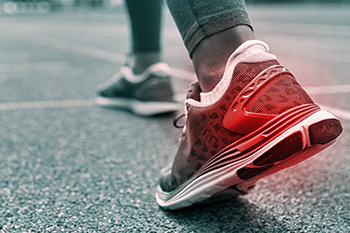June 2023

Most people experience some form of foot pain in the course of their lives. A trip to the chiropodist often leads to treatment that works to ease the pain. But in certain cases, foot pain can indicate a deeper medical problem, the main examples of which are arterial disease, arthritis, and diabetes. Millions of people develop peripheral artery disease, or PAD, as plaque builds up in the walls of their blood vessels. This constricts the flow of blood to the lower extremities and can seriously affect the feet. High blood pressure, cholesterol, and overuse of alcohol and tobacco are contributors to PAD, increasing the risk of heart attacks and strokes. Rheumatoid arthritis, or RA, also may lead to pain that begins in the toes and spreads to the feet and ankles. Joint damage caused by RA can change the shape of the feet and present other problems. Numbness and tingling in the toes and feet may be the result of diabetes, caused by high levels of sugar in the blood. Damage to the nerves that serve the feet can result in the inability to feel pain or notice cuts and sores on the feet. If these are ignored, they can become ulcerated and put one at risk for other serious problems. For help, it is suggested that you consult a chiropodist who is trained to deal with these foot-related conditions.
Foot pain can have many causes. To receive an accurate diagnosis and treatment for your foot pain, please consult with one of the chiropodists from The Footcare Centre. Our chiropodists will assess your condition and provide you with quality foot and ankle treatment.
Causes
There are a variety of different conditions that can cause foot pain, including:
Plantar fasciitis
Deformities, such as bunions or hammertoes
Injuries to the muscles, bones, tendons, or ligaments in the feet
Arthritis
Flat feet
Ingrown toenails
Symptoms
The type and location of your foot pain can help determine what may be causing it and what type of treatment options are best for you.
Common types of foot pain include:
Heel pain
Arch pain
Toe pain
Ball of foot pain
Pain that has a stabbing, burning, or tingling quality
Pain that is constant, intermittent, or that gets better or worse depending on the situation
Diagnosis
A thorough medical history and physical examination of your feet will be required to determine a diagnosis. Imaging studies, such as X-rays or MRIs may be performed to rule out or confirm certain diagnoses.
Treatment
Treatment will depend on the cause of the pain. Common treatments for foot pain include resting, icing, compressing, and elevating the affected foot, wearing orthotics, or taking anti-inflammatory medications.
If you have any questions, please feel free to contact our office located in . We offer the newest diagnostic and treatment technologies for all your foot care needs.

Choosing the right running shoe is essential for improving performance and preventing injuries while running. But this is not necessarily easy to do because a number of factors must be considered before making a purchase. Among these are running surfaces, gait or foot biomechanics, weight, and performance goals. Running shoes fall into five classifications to fit your specific needs. For instance, if you are a sprinter, lightweight shoes are a good choice. On the other end of the spectrum, a trail runner benefits from shoes that offer more support, stability, and protection. Stability shoes are a good choice for runners with few arch or pronation issues because they offer ample arch cushioning and support. Motion control shoes are helpful to runners who overpronate, as they are rigid and have a wider sole. Finally, cushioned shoes offer shock absorption features designed to account for supination problems. For help with determining which running shoe is best for your feet, it is suggested that you consult a chiropodist.
The right running shoes can sometimes be difficult to find. With so many options on the market, it’s important to know the unique needs of your feet prior to buying running shoes. If you require assistance, please consult with one of the chiropodists from The Footcare Centre. Our chiropodists can help you maintain the health of your lower limbs and your mobility.
When looking for running shoes, take into consideration:
The type of running you will be doing
The terrain you plan to run on
Your gait or running pattern
Your arch type
Other unique foot needs
A chiropodist can help by examining your feet and your gait to determine what types of shoes may be best for you. Some runners may require motion control shoes, which prevent your foot from rolling too far inward while you run. Others may need stability shoes, which offer more balance, cushioning, and support. When shopping for shoes, make sure that they are the right size, fit comfortably, and are made of breathable materials.
If you have any questions, please feel free to contact our office located in . We offer the newest diagnostic and treatment technologies for all your foot care needs.

Athlete’s foot is a common fungal infection that, while highly contagious, is generally not detrimental. Anyone who comes into direct contact with the tinea fungus can get athlete’s foot. This fungus thrives in a warm, moist atmosphere frequently found in gym locker rooms, public showers, and swimming pools. For that reason, wearing appropriate shower shoes or flip-flops in such areas is recommended. Because the fungus also can be transmitted simply by using a towel of someone who is infected, sharing towels should be avoided. An athlete’s foot infection causes itchy blisters to form between the toes or on the bottom of the feet. Sometimes, they may ooze or crack the skin, leaving the area more vulnerable. A number of antifungal creams, lotions, sprays, or powders are available to fight off the fungal infection. However, it is suggested that you seek the help of a chiropodist if your foot is red, hot, and painful, which may be signs of a more serious infection. If you have diabetes or a weakened immune system, a visit to the chiropodist is also strongly suggested.
Athlete’s foot can be uncomfortable and unsightly. To learn more about preventing and treating this condition, please consult with one of the chiropodists from The Footcare Centre. Our chiropodists will assess your condition and provide you with quality foot and ankle treatment.
What Is Athlete’s Foot?
Athlete’s foot refers to an infection of the skin on the feet that is caused by a fungus. This fungus is contagious and thrives in warm and moist environments. It is often spread in common areas such as public pools, locker rooms, and showers. It can also spread when sharing personal items, like shoes or towels, with an infected person.
Symptoms
The symptoms of athlete’s foot may include:
Itching, stinging, or burning of the skin on the feet
Cracking or peeling skin, especially between the toes and on the soles of the feet
Scaly, red rash on the foot
Blisters
Foul odor
Treatment
Treatment for athlete’s foot typically involves using over-the-counter topical antifungal medications on the feet. When over-the-counter options are ineffective, you may need to take prescription oral medications or topical antifungal drugs, or a combination of both.
Prevention
Preventing athlete’s foot places an emphasis on good foot hygiene practices.
You can prevent athlete’s foot by:
Washing and drying your feet thoroughly every day
Wearing shoes when walking in public areas
Not sharing personal items, like shoes or socks, with others
Wearing shoes and socks made out of breathable materials
If you have any questions, please feel free to contact our office located in . We offer the newest diagnostic and treatment technologies for all your foot care needs.

The ankle joint is a complex combination of bones, muscles, ligaments, tendons, and nerves. For that reason, there are many causes of ankle pain. The most common is a sprain, which happens when a ligament is stretched beyond its normal range and tears or ruptures. Another cause of ankle pain is stress fractures, which are hairline cracks in the bones that are caused by the type of repetitive pounding that occurs while running or playing sports. Other causes of ankle pain include arthritis, gout, and Achilles tendonitis. Gout is an inflammatory condition related to the overabundance of uric acid in the body. Crystals can form within the ankle joint and cause extreme pain. Achilles tendonitis is largely the result of overuse in the tendon that attaches the calf muscles to the heel. Resting the ankle is the first on the treatment list, but if bearing weight on the injured foot is difficult or impossible, it is suggested that you consult a chiropodist for help.
Ankle pain is a common symptom of many lower limb problems. If you are experiencing ankle pain, please consult with one of the chiropodists from The Footcare Centre. Our chiropodists will assess your condition and provide you with quality foot and ankle treatment.
The ankle is composed of a number of muscles, bones, tendons, and ligaments. There are many conditions which may cause ankle pain.
Causes
Ankle strains or sprains
Achilles tendon injuries
Fractures
Bursitis
Arthritis
Gout
Tarsal tunnel syndrome
Symptoms
If you have ankle pain, you may also experience a variety of other symptoms depending on the underlying cause of the pain. Some of these symptoms may include ankle swelling, bruising, redness, numbness or tingling, instability, and difficulty walking.
Diagnosis
The underlying cause of ankle pain can be diagnosed by a chiropodist. Diagnoses are typically made based on your medical history, a physical examination of the affected ankle, and imaging studies such as X-rays.
Treatment
Treatment for your ankle pain will depend on its underlying cause. Often, the chiropodist will recommend that you rest the affected ankle. You might also need to ice, compress, and elevate the ankle, wear an orthotic device, or take medications to reduce pain and inflammation.
If you have any questions, please feel free to contact our office located in . We offer the newest diagnostic and treatment technologies for all your foot care needs.
Blog Archives
- 2025
- 2024
- 2023
- 2022
- 2021
- 2020


